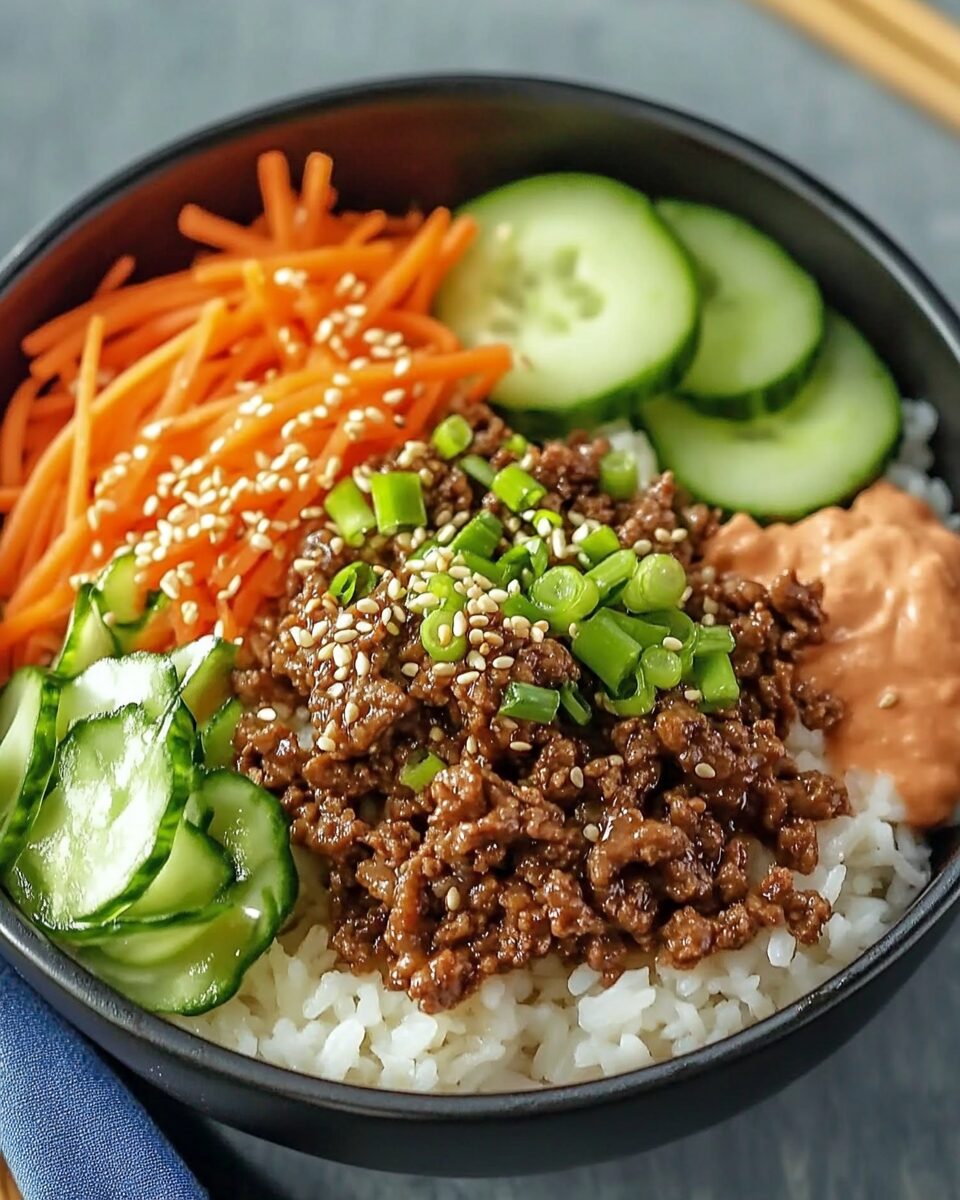Korean Beef Rice Bowls strike the perfect balance between sweet and savory, with tender, caramelized beef layered atop fluffy jasmine rice. The fresh crunch of shredded carrots and cucumbers adds a refreshing contrast, while toasted sesame seeds and green onions bring a nutty aroma and bright finish.
This bowl is a beautiful example of simple ingredients coming together to create a satisfying meal that’s both quick and comforting. Ideal for busy weeknights or meal prepping ahead, it offers a flavorful escape to Korean-inspired home cooking without complicated steps or exotic ingredients.
Full recipe:
Ingredients:
-
1 lb ground beef (preferably 80% lean)
-
3 tablespoons soy sauce
-
2 tablespoons brown sugar
-
1 tablespoon sesame oil
-
3 cloves garlic, minced
-
1 teaspoon grated fresh ginger
-
1/2 teaspoon crushed red pepper flakes (optional)
-
4 cups cooked jasmine rice
-
1 cup shredded carrots
-
1 cup sliced cucumbers
-
3 green onions, thinly sliced
-
2 teaspoons toasted sesame seeds
Directions:
-
In a large skillet over medium-high heat, add ground beef and cook until browned, breaking it up into small pieces with a spatula.
-
Drain excess fat if necessary, then reduce heat to medium.
-
Stir in soy sauce, brown sugar, sesame oil, garlic, ginger, and red pepper flakes (if using).
-
Cook for an additional 3-4 minutes, stirring frequently, until the sauce thickens slightly and the beef is well coated.
-
Divide the cooked jasmine rice between four bowls.
-
Top each bowl with the Korean beef, shredded carrots, sliced cucumbers, and green onions.
-
Sprinkle with toasted sesame seeds before serving.
Prep Time: 10 minutes | Cooking Time: 15 minutes | Total Time: 25 minutes
Kcal: Approximately 480 kcal per serving | Servings: 4 servings
Flavor Profile and Ingredients
The core of this dish is the ground beef cooked in a savory-sweet sauce that typically includes soy sauce and brown sugar, with the rich nuttiness of sesame oil and the aromatic kick of garlic and fresh ginger. This blend of ingredients delivers a dynamic range of flavors. The soy sauce provides the salty, umami backbone; the brown sugar adds sweetness and caramelization; while the garlic and ginger offer pungency and warmth. Crushed red pepper flakes add a subtle heat that can be adjusted to taste, making the dish customizable to different spice preferences.
The ground beef is browned and cooked down with these seasonings, allowing the sauce to thicken slightly and coat every morsel of meat. This results in a deliciously sticky, flavorful beef topping that’s anything but boring.
The beef sits atop a bed of jasmine rice, prized for its fragrant, slightly floral aroma and delicate texture. Jasmine rice is ideal for soaking up the juices from the beef and adding a neutral but fragrant base that balances the dish. Fresh vegetables like shredded carrots and sliced cucumbers add crunch and color, while green onions bring brightness. Toasted sesame seeds sprinkled on top add texture and a hint of earthiness that rounds out the bowl.
Nutritional Benefits and Considerations
Korean Beef Rice Bowls offer a good balance of macronutrients, with protein from the beef, carbohydrates from the rice, and vitamins and minerals from the fresh vegetables. Ground beef is an excellent source of protein, iron, and B vitamins, which are important for muscle health, energy production, and immune function.
The fresh veggies incorporated into the bowls add fiber and antioxidants, aiding digestion and supporting overall health. The use of sesame oil provides healthy fats, and sesame seeds contribute additional nutrients such as calcium and magnesium.
For those mindful of calories or dietary restrictions, this dish can be easily modified. Using leaner ground beef reduces fat content, while swapping jasmine rice for cauliflower rice or brown rice increases fiber and lowers the glycemic impact. Vegetables can also be bulked up or swapped in for even more nutrient density.
Cultural Roots and Adaptations
This recipe draws inspiration from Korean cuisine, which is known for its bold and balanced flavors. Traditional Korean meals often include a variety of banchan (small side dishes), fermented ingredients like kimchi, and rice as a staple. The Korean Beef Rice Bowl is a simplified, Americanized interpretation that captures the essence of Korean flavors but with a practical, easy-to-prepare format.
Ground beef is used instead of more traditional cuts such as bulgogi beef or short ribs, making the dish more accessible and budget-friendly. The sweetness from brown sugar mimics the marinade flavors common in Korean BBQ dishes. Sesame oil, garlic, and ginger are all classic Korean ingredients, lending authenticity to the taste profile.
This recipe is highly adaptable—while it pays homage to Korean culinary traditions, it fits well into modern eating habits and fast-paced lifestyles. It’s a prime example of how global flavors can be enjoyed in a convenient and family-friendly way.
Meal Prep and Serving Ideas
One of the standout qualities of Korean Beef Rice Bowls is their suitability for meal prepping. You can prepare a large batch of the beef mixture and store it in the refrigerator for several days, making weekday lunches or dinners a breeze. Jasmine rice can be cooked in advance and reheated without losing much of its texture or aroma.
When assembling the bowls, add fresh vegetables last to maintain their crunch and vibrant color. These bowls can be served warm or at room temperature, which makes them ideal for packed lunches or picnics.
You can also customize your bowl with additional toppings and garnishes to suit your palate. Try adding a fried or poached egg for extra protein and creaminess, kimchi for tangy spice, or avocado slices for a creamy texture. A drizzle of gochujang (Korean chili paste) or sriracha can add more heat and depth of flavor for spice lovers.
Pairing and Presentation Tips
To elevate the dining experience, presentation plays a key role. Serve the Korean Beef Rice Bowl in a deep bowl that showcases the colorful ingredients layered beautifully — the caramelized beef, bright orange carrots, crisp green cucumbers, and sprinkled sesame seeds create a vibrant and inviting dish.
Pair this meal with a simple side of steamed or sautéed greens like bok choy or spinach to complement the flavors and add more vegetables to your meal. A light miso soup or a refreshing cucumber salad with rice vinegar dressing can also round out the menu for a fuller Korean-inspired feast.
Why This Recipe Works So Well
This recipe is a great example of comfort food that also feels fresh and exciting. The familiar elements of rice and beef are given a flavorful makeover through Korean seasonings, resulting in a dish that’s easy enough for everyday meals but special enough to serve guests.
Its flexibility is another major plus. It suits a wide range of dietary needs and can be adapted for gluten-free, low-carb, or dairy-free diets with simple substitutions. It’s a dish that fits well with both quick solo dinners and family meals, making it a versatile addition to your recipe collection.
Conclusion
Korean Beef Rice Bowls combine the best of both worlds: the comforting familiarity of a beef and rice dish with the vibrant, bold flavors of Korean cuisine. This recipe is a perfect example of how simple ingredients and straightforward cooking techniques can yield a flavorful and nutritious meal that appeals to a wide audience.
Whether you are new to Korean cooking or simply looking for a quick, satisfying meal to add to your weekly rotation, this dish offers an easy and delicious solution. Its balance of sweet, savory, fresh, and nutty notes makes every bite enjoyable, while its customizable nature means you can tailor it exactly to your taste.
Adding Korean Beef Rice Bowls to your meal plan means having a go-to recipe that is both nourishing and exciting — perfect for busy lifestyles without sacrificing flavor or quality. Enjoy the vibrant taste of Korea in your own kitchen with this approachable and tasty recipe that’s sure to become a household favorite.






